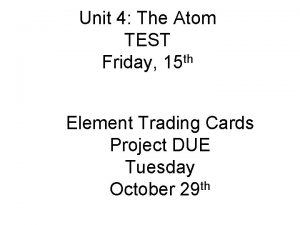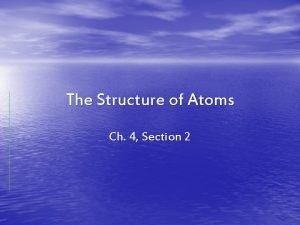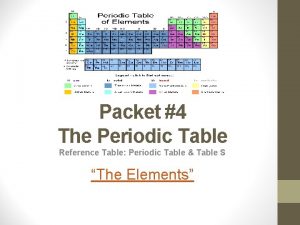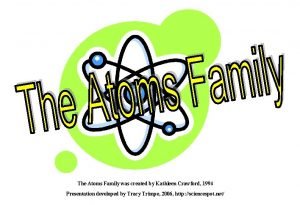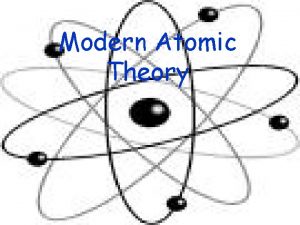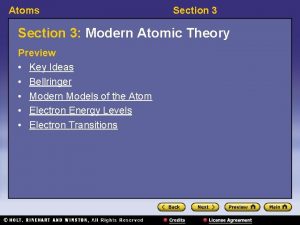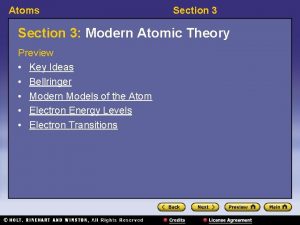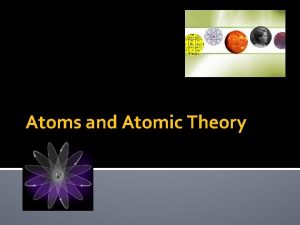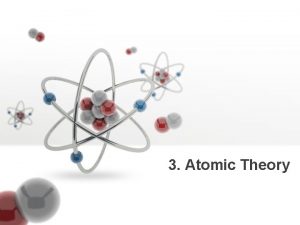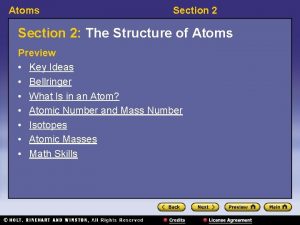Atoms Section 3 Modern Atomic Theory Preview Key














- Slides: 14

Atoms Section 3: Modern Atomic Theory Preview • Key Ideas • Bellringer • Modern Models of the Atom • Electron Energy Levels • Electron Transitions

Atoms Section 3 Key Ideas 〉 What is the modern model of the atom? 〉 How are the energy levels of an atom filled? 〉 What makes an electron jump to a new energy level?

Atoms Section 3 Bellringer In an atom, an energy level is an area around the nucleus where electrons are located. Each energy level may contain only a certain number of electrons. The electrons in an atom’s outer energy level are called valence electrons, which determine the chemical properties of an atom. The diagram below shows how many electrons can be found in each of the first four energy levels of an atom.

Atoms Section 3 Bellringer, continued 1. How many electrons does it take to fill energy level 2? 2. How many electrons does it take to fill energy level 4? 3. A lithium atom has one electron in its outer energy level. How many valence electrons does lithium have?

Atoms Section 3 Modern Models of the Atom 〉 What is the modern model of the atom? 〉 In the modern atomic model, electrons can be found only in certain energy levels, not between levels. Furthermore, the location of electrons cannot be predicted precisely.

Atoms Section 3 Modern Models of the Atom, continued • Electron location is limited to energy levels. – In Bohr’s model, electrons can be in only certain energy levels. – They gain energy to move to a higher energy level or lose energy to move to a lower energy level.

Atoms Section 3 Visual Concept: Electron Energy Levels

Atoms Section 3 Modern Models of the Atom, continued • Electrons act like waves. • The exact location of an electron cannot be determined. • orbital: a region in an atom where there is a high probability of finding electrons

Atoms Section 3 Visual Concept: Comparing Models of the Atom

Atoms Section 3 Electron Energy Levels 〉 How are the energy levels of an atom filled? 〉 The number of energy levels that are filled in an atom depends on the number of electrons. • valence electron: an electron that is found in the outermost shell of an atom and that determines the atom’s chemical properties

Atoms Section 3 Electron Energy Levels, continued • There are four types of orbitals. – Orbital types are s, p, d, and f. – Each orbital can hold 2 electrons. • Orbitals determine the number of electrons that each level can hold.

Atoms Section 3 Electron Transitions 〉 What makes an electron jump to a new energy level? 〉 Electrons jump between energy levels when an atom gains or loses energy.

Atoms Section 3 Electron Transitions, continued • The lowest state of energy of an electron is called the ground state. • If an electron gains energy by absorbing a photon, it moves to an excited state. – photon: a unit or quantum of light • The electron releases a photon when it falls back to a lower level. • Photons have different energies. The energy of a photon corresponds to the size of the electron jump.

Atoms Section 3 Electron Transitions, continued • Atoms absorb or emit light at certain wavelengths. – Because each element has a unique atomic structure, the wavelengths emitted depend on the particular element. – So, the wavelengths are a type of “atomic fingerprint” that can be used to identify the substance.
 The atoms family atomic math challenge answer key
The atoms family atomic math challenge answer key Periodic table of elements regents
Periodic table of elements regents Chapter 4 section 2 the structure of atoms answer key
Chapter 4 section 2 the structure of atoms answer key Chemistry in biology section 2 chemical reactions
Chemistry in biology section 2 chemical reactions Quantum mechanical model
Quantum mechanical model Electrons in atoms section 2 quantum theory and the atom
Electrons in atoms section 2 quantum theory and the atom Periodic reference table
Periodic reference table Atoms family song
Atoms family song Http sciencespot net
Http sciencespot net The atoms family atomic math challenge
The atoms family atomic math challenge The atoms family atomic math challenge
The atoms family atomic math challenge Is atomic mass and relative atomic mass the same
Is atomic mass and relative atomic mass the same Ion size trend
Ion size trend Ionization energy trend periodic table
Ionization energy trend periodic table Is atomic mass and relative atomic mass the same
Is atomic mass and relative atomic mass the same
